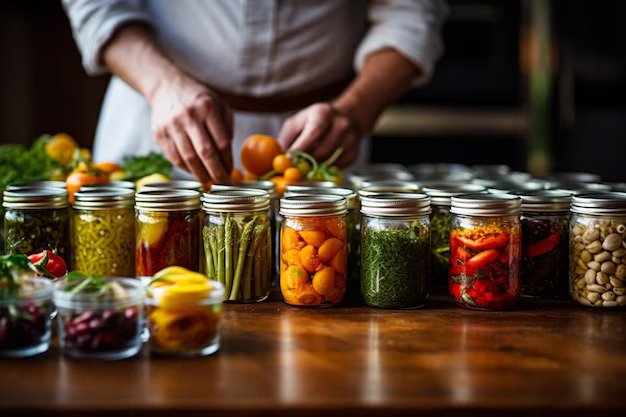 11 october, 2023
11 october, 2023
Eating a diet rich in fruits and vegetables is essential for maintaining good health, but
sometimes it can be difficult to consume all of the produce you buy before it goes bad.
Fortunately, there are many different ways to store and preserve fruits and vegetables so that
you can enjoy them even when they are out of season.
One of the easiest ways to store and preserve fruits and vegetables is to freeze them. Many fruits and vegetables can be frozen without losing much of their nutritional value or texture. Berries, leafy greens, and most vegetables can be frozen without blanching, while fruits like peaches, apples and pears should be blanched before freezing. To freeze fruits and vegetables, simply wash them thoroughly, dry them, and then place them in airtight bags or containers before placing them in the freezer
Another way to store and preserve fruits and vegetables is through canning. This is a great way to store fruits and vegetables long-term, but it does require some equipment and knowledge of the process. Canning fruits and vegetables involves heating them to a high temperature to kill any bacteria, and then sealing them in jars to prevent re-contamination. It's important to note that not all fruits and vegetables are suitable for canning, and it's important to follow proper canning methods and recipes to ensure that the food is safe to eat.
Fermenting is also a good way to preserve fruits and vegetables. Fermenting involves allowing fruits and vegetables to sit in a brine solution, which encourages the growth of beneficial bacteria. These bacteria break down the food and create lactic acid, which helps to preserve the food and gives it a tangy, sour flavor. Fermenting is a great way to preserve vegetables such as cucumbers and cabbage, and can also be used to make fermented fruits like cranberries or apricots.
Drying is another way to preserve fruits and vegetables. Drying fruits and vegetables removes most of the water from them, which slows down the growth of bacteria and other microorganisms. Drying is a great way to preserve fruits like apples, apricots and berries, and vegetables like tomatoes, mushrooms and peppers. Drying can be done using a dehydrator or in a low-heat oven.
Finally, pickling is a great way to preserve fruits and vegetables. Pickling involves soaking fruits and vegetables in vinegar or a vinegar-based brine solution. This helps to preserve the food and gives it a tangy, sour flavor. Pickling is a great way to preserve vegetables like cucumbers, carrots and bell peppers.
In conclusion, there are many ways to store and preserve fruits and vegetables for long-term use. Freezing, canning, fermenting, drying, and pickling are all great options that can help to extend the shelf life of your produce. By storing and preserving fruits and vegetables, you can enjoy them even when they are out of season, and ensure that you always have healthy, fresh produce on hand.
One of the easiest ways to store and preserve fruits and vegetables is to freeze them. Many fruits and vegetables can be frozen without losing much of their nutritional value or texture. Berries, leafy greens, and most vegetables can be frozen without blanching, while fruits like peaches, apples and pears should be blanched before freezing. To freeze fruits and vegetables, simply wash them thoroughly, dry them, and then place them in airtight bags or containers before placing them in the freezer
Another way to store and preserve fruits and vegetables is through canning. This is a great way to store fruits and vegetables long-term, but it does require some equipment and knowledge of the process. Canning fruits and vegetables involves heating them to a high temperature to kill any bacteria, and then sealing them in jars to prevent re-contamination. It's important to note that not all fruits and vegetables are suitable for canning, and it's important to follow proper canning methods and recipes to ensure that the food is safe to eat.
Fermenting is also a good way to preserve fruits and vegetables. Fermenting involves allowing fruits and vegetables to sit in a brine solution, which encourages the growth of beneficial bacteria. These bacteria break down the food and create lactic acid, which helps to preserve the food and gives it a tangy, sour flavor. Fermenting is a great way to preserve vegetables such as cucumbers and cabbage, and can also be used to make fermented fruits like cranberries or apricots.
Drying is another way to preserve fruits and vegetables. Drying fruits and vegetables removes most of the water from them, which slows down the growth of bacteria and other microorganisms. Drying is a great way to preserve fruits like apples, apricots and berries, and vegetables like tomatoes, mushrooms and peppers. Drying can be done using a dehydrator or in a low-heat oven.
Finally, pickling is a great way to preserve fruits and vegetables. Pickling involves soaking fruits and vegetables in vinegar or a vinegar-based brine solution. This helps to preserve the food and gives it a tangy, sour flavor. Pickling is a great way to preserve vegetables like cucumbers, carrots and bell peppers.
In conclusion, there are many ways to store and preserve fruits and vegetables for long-term use. Freezing, canning, fermenting, drying, and pickling are all great options that can help to extend the shelf life of your produce. By storing and preserving fruits and vegetables, you can enjoy them even when they are out of season, and ensure that you always have healthy, fresh produce on hand.
For more information and further details about our products, please contact us